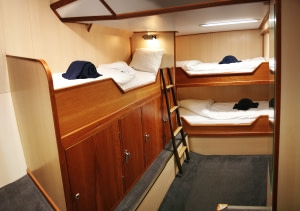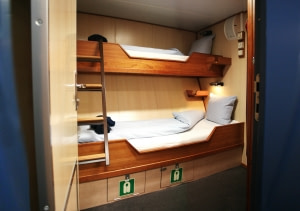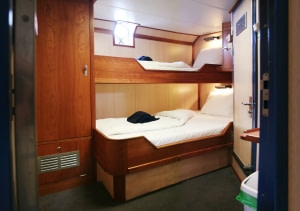| Titel: | Nord Spitzbergen, Arktische Sommer |
| Daten: | |
| Reisecode: | RVR15-26 |
| Dauer: | 19 Nächte |
| Schiff: | SV Rembrandt van Rijn |
| Einschiffung: | Longyearbyen |
| Ausschiffung: | Longyearbyen |
| Sprache: | Englisch sprechende Reiseleitung |
| Mehr über: | |
Diese Reiseroute dient nur zur Orientierung. Das Programm kann je nach Eis-, Wetter- und Wildtierbeobachtung variieren. Anlandungen sind abhängig von der Verfügbarkeit von Plätzen, Genehmigungen und Umweltbelangen gemäß AECO-Vorschriften. Offizielle Fahrpläne und Anlandeplätze werden vor Beginn der Saison mit AECO festgelegt, aber der Expeditionsleiter bestimmt den endgültigen Fahrplan. Flexibilität ist von größter Bedeutung auf unseren Schiffsreisen mit Expeditionscharakter. Bereitschaft zum Komfortverzicht sind Grundvoraussetzung an Bord eines historischen Traditionssegelschiffes. Wichtiger Hinweis zum Segelprogramm: das Schiff ist mit Segeln ausgestattet und diese werden bei guten Bedingungen (offene See, Wassertiefe, passende Windverhältnisse, Zeitverfügbarkeit) auch eingesetzt. Dieses ist aber nicht garantiert. Der Kapitän entscheidet über Einsatz der Segel oder des Motors. Falls Segel zum Einsatz kommen, werden diese von der Crew bedient. Die Gäste folgen den Sicherheitsanweisungen der Mannschaft. Die Durchschnittsgeschwindigkeit der s/v Rembrandt van Rijn ist 6,5 Knoten.
Die Nord-Spitzbergen-Kreuzfahrt führt zu einigen der abgelegensten Orten Nordeuropas. Die Expedition bietet Ihnen die Möglichkeit, Überreste aus der Walfangzeit, Gletscher, eine Vielzahl von arktischen Vögeln einschließlich der Krabbentaucher sowie Eisbären zu sehen.
Tag 1: Die größte Stadt auf der größten Insel
Sie landen in Longyearbyen, dem Verwaltungszentrum von Spitzbergen, gelegen auf der größten Insel des Svalbard-Archipels. Genießen Sie einen Bummel durch die ehemalige Bergbaustadt, mit ihren faszinierenden Attraktionen - der Pfarrkirche und dem Svalbard Museum. Obwohl die Siedlung sehr dicht bebaut ist sind mehr als hundert Pflanzenarten im Gebiet nachgewiesen. Am Nachmittag fahren wir hinaus in den Isfjord und es könnte sein, das wir unseren ersten Zwergwal zu Gesicht bekommen. Am Abend segeln wir nach Trygghamna, wo wir am nächsten Morgen die Überreste einer englischen Walfangstation aus dem 17. Jahrhundert und einer Jagdstation der Pomoren aus dem 18. Jahrhundert besichtigen können.
Day 2: Foxes, seabirds, and grazing reindeer
From Trygghamna you walk to Alkhornet, a large seabird cliff where the birds are scouting out breeding places. Below the cliffs is a common place to spot Arctic foxes, and you may also see reindeer grazing on the lush vegetation if there’s not too much snow.
Day 3: Fuglefjorden to Raudfjorden
You sail into Fuglefjorden amid views of Svitjodbreen and Birgerbukta, both breeding places for great skuas as well as likely spots to spy a polar bear. Raudfjorden, on the north coast of Spitsbergen, is a fine area for gazing over the glaciers. It’s also a favorite hangout for ringed and bearded seals, colonies of seabird, and the occasional polar bear and beluga whale.
Day 4 - 7: Onward to east Greenland
You may eventually see the jagged edge of the east Greenland sea ice flashing into sight ahead, depending on the conditions. Keep watch for whales and migrating seabirds here.
Day 8: Remains of the trappers
The goal is to sail into Foster Bay, making your first landing at Myggbukta in the late afternoon or evening. Beyond the old hunters’ hut (where, in the first half of the 20th century, Norwegian trappers hunted for polar bear and Arctic fox) there is a sprawling tundra populated by musk oxen, with geese floating the small lakes.
Day 9: Bright bergs, big mountains
You sail through Kaiser Franz Joseph Fjord, enjoying its lofty mountains and bright interior icebergs. In the evening you reach Teufelsschloss, a prominent mountain that comprises part of the Eleonora Bay Supergroup: sedimentary rock created between 950 – 610 million years ago to a depth of 16 km (10 miles). This rust-red multi-layered unique geology defines the scenery over the coming days.
Day 10: The essential Arctic
Landing at Blomsterbugten, you have a good chance of spotting Arctic hare and musk oxen. Noah Lake is home to great northern divers as well as their young, and the hiking opportunities here are numerous. In the afternoon you venture deeper into Kaiser Franz Joseph Fjord, finding shelter in Renbugten. Colossal icebergs and quintessential Arctic scenery accompany you while passing through this narrow fjord system.
Day 11: Into the Antarctic Sound
Today the aim is to land in Renbugten in search of musk oxen and Arctic hares. Around lunch you head east into the inversely named Antarctic Sound, enjoying views of the ancient sedimentary rock. You should arrive at Maria Island before nightfall.
Day 12: Meeting Menander
You cut into Kong Oscars Fjord for an attempted landing near Menander Øer, a location with lively walking opportunities.
Day 13: Colors of Arctic autumn
Continuing east, you land in Antarctic Havn. You spend the afternoon in this expansive valley, where you can see groups of musk oxen. At this time of year, the sparse vegetation is colored with golden fire. Your guide may be able to tell you about the intriguing geopolitics that played out here in the early 1930s between Norway and Denmark.
Day 14: Sailing to Scoresby Sund
Spending the day at sea, you make for the largest fjord system in the world: Scoresby Sund.
Day 15: Inuit neighborhood of yesteryear
Today you reach Scoresby Sund, sailing along the glaciated Volquart Boons Kyst. You may also enjoy a Zodiac cruise past one of the glacier fronts, along with a visit to the basalt columns and ice formations of Vikingebugt. The afternoon goal is to visit Danmark Island, where you find the remains of an Inuit settlement abandoned around 200 years ago. The circular stone tent rings indicate the summer houses, while the winter houses can be seen closer to a small cape. The sites are well preserved, with easy identifiable entrances, bear-proof meat caches, and grave sites. During the afternoon, you sail along the east side of Milne Land amid a number of scattered icebergs.
Day 16: Enormous icebergs near Sydkap
You land near Sydkap, where Arctic hares are often seen, and during lunch you get a glimpse of the entrance to Nordvestfjord in Scoresby Land. Here you encounter colossal icebergs, some over 100 meters high (328 feet) and more than a kilometer in length (.6 mile). Most of these bergs are grounded, as the fjord is only about 400 meters deep (1,312 feet).
Day 17: The tundra of Jameson Land
At the western shores of Jameson Land lies a vast tundra with grazing musk oxen. We will try to make a landing on one of the areas, such as Tyskit Nunat, remembering Alfred Wegener’s efforts to cross Vandreblokken. We may also visit Kap Hooker or a lovely lagoon west of Kap Stewart.
Day 18: Settlement at Scoresby Sund
Today’s stop is Ittoqqortoormiit, the largest settlement in Scoresby Sund at about five hundred inhabitants. At the post office you can buy stamps for your postcards or just stroll around to see the sled dogs and drying skins of seals and musk oxen.
Day 19: The hikes of Hurry Inlet
In the morning you stop on the south coast of Jameson Land, at a lagoon near Kap Stewart. Here the waders and geese are collecting for their autumn migration, and musk oxen and collared lemmings survive on the meager vegetation. Further inside Hurry Inlet, you may take a walk near the head of the fjord as well as one of the rivers that terminate here. Here is a chance of a climb up the mountain of J.P. Koch Fjeld, near Hareelv. In this remarkable area, scientists found fossils that linked fish and amphibians in the lower Cretaceous period. You spend the night at anchor off Constable Pynt.
Day 20: Final call at Constable Pynt
We take the chartered plane from Constable Pynt to Keflavik taking home memories for a lifetime.
Highlights die Sie erleben können
SV Rembrandt van Rijn
Kabinen & Preise

Dreifaches privates Bullauge
- 1 Bullauge 1 obere/untere Koje + 1 untere Koje Private Dusche und Toilette Viel Stauraum
Komplette kabine
Preis für die komplette Kabine, voll besetzt.
Liegeplatz teilen
Teilen Sie Ihre Kabine mit anderen zum besten preis

Private Doppelkabine innen
- 1 obere / untere Schlafkoje
- Private Dusche und Toilette
- Reichlich Stauraum
Komplette kabine
Preis für die komplette Kabine, voll besetzt.
Einzelkabine
Preis für die komplette Kabine bei Belegung mit 1 Person ({rate}-facher geteilter Preis).
Liegeplatz teilen
Teilen Sie Ihre Kabine mit anderen zum besten preis

Private Doppelkabine mit Bullauge
- 1 Bullauge
- 1 obere / untere Schlafkoje
- Private Dusche und Toilette
- Reichlich Stauraum
Komplette kabine
Preis für die komplette Kabine, voll besetzt.
Einzelkabine
Preis für die komplette Kabine bei Belegung mit 1 Person ({rate}-facher geteilter Preis).
Liegeplatz teilen
Teilen Sie Ihre Kabine mit anderen zum besten preis